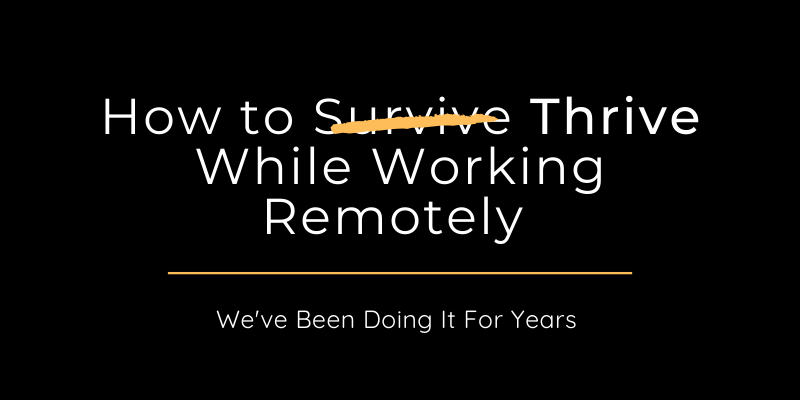Yes, remote work is a trending topic right now because of Coronavirus. (And, yes, I’m annoyed I didn’t think of the below headline first). But how to effectively integrate remote employees into your workforce has been a subject in management circles for almost two decades.

It’s also not a new conversation during times of global crises. Following the 9/11 attacks in the U.S., The New York Times published this Letter to the Editor in which one reader suggests telecommuting as a way to “enable employees to continue working without enduring the stress of going into the office.”
The tech industry has been more amenable to shifting mindsets around what is now more commonly referred to as “working remotely” (taking into account how mobile our work has become in the last 20 years.) However, some of our colleagues who work for the more traditional tech enterprises tell us that there is still an unspoken understanding about showing up in the office. Your physical presence equates with dedication in the minds of some managers.
I’ve been working remotely in-part or in-full for most of my career (20+ years).
While it’s only been in the last few years I’ve had a job that has been entirely remote, I’ve been fortunate to work for multiple employers in the past who either have seen the benefit of offering flexible accommodations to their employees, or at least have understood that a little flexibility is a worthwhile investment in an employee they value and hope to keep around.
It’s remarkable to me how slow the adoption of remote work has been despite advancing technologies, so many of which make remote work easy– free high-speed internet everywhere, cheap mobile devices, free web-based word processing software.
In a lot of cases, hiring staff who work mainly from home can even save organizations time and money. (In fact, we wrote recently about how hiring freelancers can help you cut between 40% – 100% of staffing-related costs.)
If there is anything positive about a pandemic (there isn’t), it would be how companies, who may not have otherwise, are learning how remote work is not as menacing as they imagine.
(Have you seen the circulating joke yet about how now we’ll really know which meeting could have been an email?)
In recent days, we’re even seeing a number of companies publicly announcing newly enacted policies encouraging employees to work from home. Box is the latest to join this trend.
Surely the tech industry is at the forefront of supporting remote work — with companies such as GitLab being famous for being all-remote way before Coronavirus hit the scene. And yet, there are still many tech companies who don’t. In 2017, IBM made news for bringing many of their remote positions back into the physical office.
IOD Is All-Remote
If you consider a co-working space like WeWork “remote” — IOD is technically all-in with remote work. While some on our management team conduct most of their business in a space in WeWork, the rest of us work from home, the road, the plane, the beach, the doctor’s office, the grocery store, and any other place that isn’t in an internet Dead Zone.
In fact, for the last three years, our core staff at IOD has worked in three different countries, three different time zones. Our freelance experts and writers span almost 20 countries.

Then there are our clients, some of whom are in different time zones than any of ours. IOD’s combined office hours are much longer than the traditional company’s–which can be challenging sometimes–but it also means that each of us gets to customize our work days, tailoring them to our productivity type and the demands of our personal lives, whether that’s picking our kids up from school, driving our elderly parents to the dentist, or just generally catching up on our to-do list.
How do we do it?
I checked in with some of my colleagues to get their insights, tips, and quips on what it’s like for them to work remotely. Hopefully, these introductory tips will be useful to companies who are scurrying to adjust their processes and schedules to this unexpected work-from-home scenario caused by Covid-19. Hopefully, once organizations see how non-threatening it is, they’ll adopt a remote work mindset permanently, even when this pandemic passes.
The Must-Have Tools
Anyone who has been following Coronavirus news knows how Zoom’s stock increased as much as 70% in recent weeks. (Some investors were so eager to buy stocks in the telecommunications company that they mistakenly purchased those belonging to the wrong company.) Microsoft has benefited too, seeing a 500 percent increase in Microsoft Teams meetings, calling, and conferencing in China.
At IOD, we’re Zoom users. Zoom has become a common noun for us, as in “can you open up a zoom?” Just like other companies our size, we have regular bi-weekly management meetings on the calendar. But unlike many other companies, our management meetings are always online, and always by Zoom (save for the one time each year we meet up IRL.)
I’ve used Google Hangouts, too, for some client or vendor calls, but we all find Zoom to be easy-to-use and reliable in terms of connection.
The other main tools we have been using for remote operations since IOD expanded exponentially in 2017 are:
- Slack — where we have both internal channels for staff discussions and an external channel to communicate en masse with our freelancers.
- Asana — where we traffic and monitor all of our projects.
- Google Drive — I daresay every single document produced for a client lives in Google Drive and we insist all our content creation clients leave all comments inside the Google Doc for ease of tracking.
- WhatsApp — Most of us at IOD are online on Slack during the traditional 9 – 5 business-day week (in our own time zone), but since we also operate in different time zones, we may use WhatsApp from time to time to reach out in an emergency when our co-worker has signed off of Slack for the day
All our accounting is handled online, as are our payment systems and freelancer contracts.
The only physical papers ever passed between myself and an IOD colleague were business cards we produced a few years ago. Now, as we consider a re-brand for later this year, I’m not even sure I would spend the money on business cards.
On top of the above, IOD has a WeWork membership, which means that any of us, whether in our hometown or on the road (in any one of 22 countries), can take advantage of a hot desk (on-demand workspace) when at-home is not ideal for what we have on our plate that day. We take meetings at WeWork, for instance, or in my case, I’ll work from my favorite WeWork location in Philly when I feel a craving for human interaction or want to avoid the laundry piling up at home which tends to be one of my greatest distractions.

What’s the Biggest Challenge Working Remotely?
Understandably, employers are often less focused on the challenges their employees may meet when working outside the office, and more concerned about the impact on workflow and output.
That said, there are challenges to working from home, and moreso during times of fear and chaos.
In order for employees to prove to their employer that they can produce as good if not better results from home or from the local coworking space, they better be prepared for distractions, whether those distractions be children, dogs, Netflix, or laundry.
I asked our team what their biggest remote-work challenges are and how they deal with them. Here’s what you may have to face if you end up working from home:
Ofir Nachmani, CEO, Based in Tel Aviv: “For me, it’s my kids. But they learned quickly that when their father is working, they are not allowed to enter my home office. I try to do work when they are not at home, but it was important to teach them that boundary.”
Slavko Dimitrijevic, Traffic Manager, Based in Serbia: “The only challenge is that your living quarters become your workspace, and so sometimes it can feel like you’re living in a cage. Make sure to take breaks outside. Or, sometimes I will work from the local cafe to get a change of scenery.
Ivan Arsenov, Talent Acquisition Manager, Based in Serbia: “My biggest challenge is not watching The Wire over and over. Whatever your distraction is, the best way to deal with it is to create a schedule for yourself and keep to it. ”
Trust, Yes, But Also Letting Go
In a conversation on this topic on Twitter this week, I remarked how odd it is to me that employers would trust their staff with expensive equipment, sensitive data, and intellectual property, but claim they don’t trust their employees to manage their time effectively working from home.
This makes absolutely no sense. My colleagues and I all agree that trust is the #1 critical element to a successful remote company culture. Here’s what they had to say about it:
Petar Marinkovic, CTO, Based in Serbia: “Hire the right people and trust those people you hired. There aren’t really guidelines to make someone productive at home, if that person isn’t productive on their own.”
Ofir Nachmani: “Ongoing communication (with video on when possible) makes me feel connected to the staff at IOD. We are all transparent when we have a doctor’s appointment to go to in the middle of the day, or if a child at home is making it too difficult to have a scheduled meeting. However, the most important tip for employers who are counting on remote workers is KPIs. If a team member has a KPI to meet or a deliverable to produce, and does, and you are seeing results from them, why do you care where they are working?”
Yes, We Know There Are Some Security Issues
Certainly there are some organizations such as financial institutions who may have security issues more serious than the ones IOD has to navigate –such as sensitive data traveling across unsafe WiFi networks. Security is probably the biggest legitimate challenge to organizations embracing remote work.
However, let’s be real: how much is your company really susceptible to, or at risk from, security breaches?
Why Are Some Companies Still Resistant?
We strongly recommend you let go of the antiquated belief that good employees show up at the office at 8:30 am and stay at the office until 6:30 pm,.
We also recommend that if you do allow flexible work schedules to your staff, don’t start tracking employees who work from home, don’t overly monitor them (and especially not secretly), and don’t act manipulative if you’re feeling that a work-at-home employee is not meeting goals. For instance, don’t call an employee in the middle of the afternoon to make sure he is on the job and not at the gym.
Such a move is counterproductive and a breach of trust on your behalf, as manager.
When it comes to running a production floor of a factory, I get having on-site employees, in-person technicians. But when it comes to small-to-midsize tech companies, I don’t know why companies have been so reluctant before COVID-19 forced them to consider remote work.
Yeru Chernilovsky, Head of Editorial (and based in Israel), says, “It’s the fear of change. Change is difficult, especially when the office work culture has been the norm for so long. Companies fear losing control of their employees, decreased productivity, less collaboration, and loss of interpersonal interactions.”
Yes: fear of change. But, also loss of control, loss of a sense of security, even power. If you can’t see your employees, are they even real?
Letting go of control of where and at what time your employee works is not irresponsible leadership. In fact, sometimes offering your employees a longer leash, so to speak, is the perfect way to learn the depth of their capabilities and commitment, and give them the opportunity to be at their most productive.
Hiring remote workers opens you up to the possibility of hiring better talent, at better rates. It allows you to support your valued employees in their need for optimal workspace, work environment, and work conditions. It’s been our experience at IOD that when you don’t care if your employee is leaving to go to a soccer match at 4pm — as long as he is meeting his goals — your employee feels more grateful for his job, and therefore wants to give more to the company. That employee stays with the company longer, and gives the company his time after hours when needed.
No Time for Baby Steps
If we weren’t in the middle of a worldwide pandemic forcing people into quarantine, perhaps you may want to take baby steps: start with one department, start with a one-day-a-week work-from-home option and track how it affects productivity over half a year. 69% of companies in 2019 did just that.
But we don’t have that kind of time anymore. As of the writing of this post, the U.S. stock market is being affected by this virus, as is the global travel industry, and social interactions on every continent. The latest report from Italy is that the entire country is shut down. Israel has enacted severe restrictions for travel in and out of the country. In the US, some counties have already been impacted by school closures, and many workers have been asked to take unpaid leave.
We at IOD feel lucky — really lucky — that for now most of our work routine is the same as it ever was. Thanks to Zoom, Slack, Google, WhatsApp, Twitter, Asana and various other means of internal and external communications; not to mention transparency, trust, industriousness, commitment, and our eyes on KPIs. (Which means that now’s also a good time to reach out to us about your content creation needs.)
And generosity. Generosity more often than not breeds generosity. Even in the workplace.
Wishing you good, good health.









